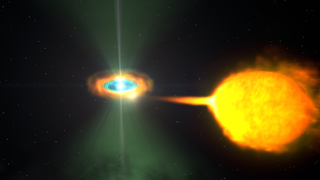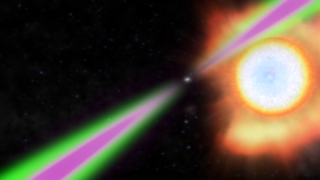Black Widow Pulsars Consume Their Mates
The essential features of black widow and redback binaries are that they place a normal but very low-mass star in close proximity to a millisecond pulsar, which has disastrous consequences for the star. Black widow systems contain stars that are both physically smaller and of much lower mass than those found in redbacks.
So far, astronomers have found at least 18 black widows and nine redbacks within the Milky Way, and additional members of each class have been discovered within the dense globular star clusters that orbit our galaxy.
One black widow system, named PSR J1311-3430 and discovered in 2012, sets the record for the tightest orbit of its class and contains one of the heaviest neutron stars known. The pulsar's featherweight companion, which is only a dozen or so times the mass of Jupiter and just 60 percent of its size, completes an orbit every 93 minutes – less time than it takes to watch most movies.
The side of the star facing the pulsar is heated to more than 21,000 degrees Fahrenheit (nearly 12,000 C), or more than twice as hot as the sun's surface. Recent studies allow a range of values extending down to 2 solar masses for the pulsar, making it one of the most massive neutron stars known.
Watch the video to learn more about this system and its discovery from some of the scientists involved.
Related
For More Information
Credits
Walt Feimer (HTSI): Animator
Dana Berry (Skyworks Digital): Animator
Scott Wiessinger (USRA): Animator
Scott Wiessinger (USRA): Video Editor
Alice Harding (NASA/GSFC): Interviewee
Paul Ray (NRL): Interviewee
Roger Romani (Stanford University): Interviewee
Holger Pletsch (Albert Einstein Institute): Interviewee
Karen Fox (ADNET Systems, Inc.): Narrator
Scott Wiessinger (USRA): Producer
Roger Romani (Stanford University): Scientist
Rob Andreoli (Advocates in Manpower Management, Inc.): Videographer
Francis Reddy (Syneren Technologies): Writer
Scott Wiessinger (USRA): Writer
NASA's Goddard Space Flight Center
https://svs.gsfc.nasa.gov/11216
Mission:
Fermi Gamma-ray Space Telescope
This item is part of these series:
Narrated Movies
Astrophysics Animations
Astrophysics Stills
Astrophysics Features
Goddard TV Tape:
G2013-004 -- Fermi Black Widow Pulsar
Keywords:
SVS >> HDTV
SVS >> Music
SVS >> Neutron Star
GCMD >> Earth Science >> Spectral/Engineering >> Gamma Ray
SVS >> Astrophysics
SVS >> Pulsar
SVS >> Edited Feature
SVS >> Space
SVS >> Fermi
SVS >> Interview
SVS >> Binary Star
DLESE >> Narrated
SVS >> Star
SVS >> Radio Telescope
NASA Science >> Universe
GCMD keywords can be found on the Internet with the following citation: Olsen, L.M., G. Major, K. Shein, J. Scialdone, S. Ritz, T. Stevens, M. Morahan, A. Aleman, R. Vogel, S. Leicester, H. Weir, M. Meaux, S. Grebas, C.Solomon, M. Holland, T. Northcutt, R. A. Restrepo, R. Bilodeau, 2013. NASA/Global Change Master Directory (GCMD) Earth Science Keywords. Version 8.0.0.0.0













